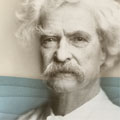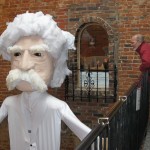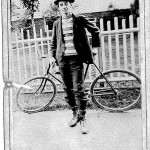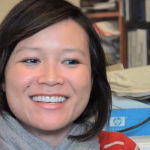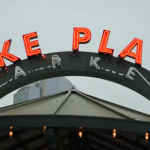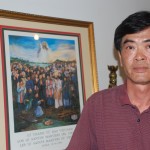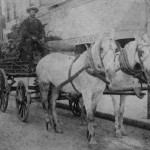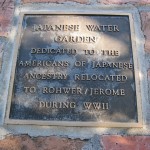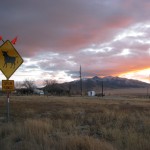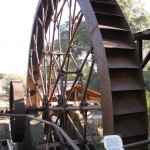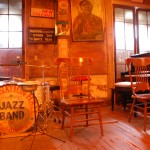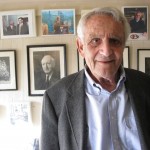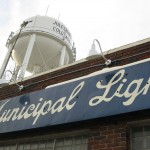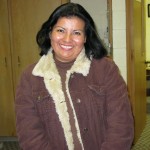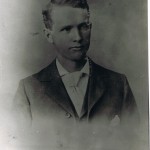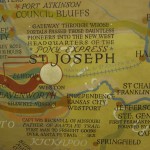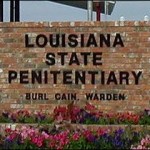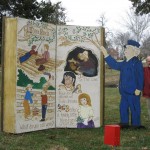We race west across Nevada and California to find places where Mark Twain worked, and we find, instead, places he sort of, kind of, well, he didn’t work.
In the freezing basement of a Virginia City, Nevada, gift shop, on the mining town’s main street we walk around the Territorial Enterprise museum, complete with a painting and pictures of Mark Twain. Except Twain wrote for the Territorial Enterprise when it was located in another Virginia City building that no longer exists. But we do see Mark Twain’s desk and a table where reporters ate, wrote and slept. The museum sign by the table reads: “Yes, Mark Twain slept here, too.”
In Carson City, Nevada, we visit the capitol, except that this capitol, built in 1870, was completed after Twain wrote from Carson City about Nevada’s capital politics for the Territorial Enterprise. But State Controller Kim R. Wallin shows us her desk, which President Lincoln supposedly gave to Nevada’s governor upon statehood (and where Twain supposedly sat).
We also pose in Governor Brian Sandoval’s outer office in front of a sculpture titled “Roughing It Mark Twain” and accept commemorate Sandoval coins that we take to flipping, heads or tails, to decide important life decisions like who will be stuck driving the van for the next two hours.
Near Angels Camp, California, we visit a cabin on Jackass Hill Road that commemorates the presence of Twain and his story-telling buddies, Jim and Bill Gillis and Bill Stoker, during the winter of 1864-65. A plaque says that Twain, while living on the hill, “heard the story of the ‘Jumping Frog’ in an Angels Camp saloon. His version would transform his life.” Except that this cabin was built in 1922, more than a decade after Twain’s death, and restored in 2002-05 by the Sonora Sunrise Rotary Club.
One of a road trip’s greatest thrills is to discover what you are not searching for…and to find it even more fascinating than what you originally were seeking. We were planning to visit the Angels Camp Museum to view its exhibit about Mark Twain and the local story that made him famous, “The Celebrated Jumping Frog of Calaveras County.” But the museum was closed for the season, and Museum Director Craig Hadley was out of town.
Fortunately for us he arranged long-distance for Susan Rudolph, the museum’s archivist, to give us a tour not only of the museum’s Twain exhibit but also of its collections about early Angels Camps and the area’s mining industry.
The museum’s extensive mining collection includes everything from a three-story-tall waterwheel, to a rocking chair made of a gunny sack for its back and a wooden Hercules Powder dynamite box for its seat, to The Monster, a giant, cannon-like iron nozzle used in hydraulic mining. That form of mining, reportedly the largest and most destructive, so polluted rivers and streams that it was outlawed in 1884.
As interesting as we find the exhibits, Rudolph’s tales about local residents, those excluded and included from living in town and working in the mines, prove even more fascinating. Rudolph, 49, a Pasqua Yaqui Indian on her mother’s side, tells of the Mi-Wuk Indians, area residents for thousands of years, forced to live on a reservation near Eight Mile Road, and of the Mexicans, also required to live on the town’s outskirts and excluded from working in the mines. Whites felt Native Americans and Mexicans “worked too cheap,” Rudolph says. Chinese were allowed to settle in town and mine. They mined scientifically and systematically, successfully reworking creeks, writes Judith Marvin, “after Euro-Americans had removed the more readily available gold.”

Susan Rudolph shows us an antique cage in the museum's archives, which was used to transport jumping frogs
Given the history of my great-grandfather Angelo Ghiglione, who came to the United States from near Genoa, Italy, in 1872, I am surprised to learn from Rudolph of Genovese immigrants coming to this remote mountain mining town at roughly the same time. Rudolph takes us to the museum’s archive to show us the remains of an exhibit about the Airola, Bolleri, Cassinelli, Cerruti and Lagomarsino families and other local Genovese who, after trying mining, went into law, government and business. “They made a lot of money off those miners,” Rudolph said.
A photo, circa 1890, shows the Main Street merchandise store of John Peirano and his wife Julia. When John died, Julia took over the store. When she died, the town shut down to attend her funeral and mourn their loss.
James Romaggi made a princely $30,000 in five months from mining, then developed a 100-acre farm and, using his stone-mason skills, built a bar/card room/stagecoach stop. That building is the subject of a foundation formed in 2002, “Save the Romaggi Adobe Foundation.”
The Angels Camp Museum has saved the historic Sam Choy building—a merchandise store from 1860 to 1892—and plans to use it to emphasize the cultural diversity of Calaveras County, which was home to 3,000 Chinese by 1860, and to create a special exhibit on the Chinese immigrants of Angels Camp.
Loren Ghiglione



